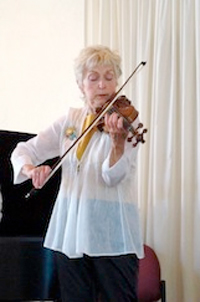by Jeremy Reynolds
Violinist Marilyn McD
Jeremy Reynolds: I see that BPI is celebrating its 44th season this year. Congratulations. How long have you taught at BPI, how has it changed over the years?
Marilyn McDonald: I’ve been there from the beginning. First of all, you should understand that this was the very first early music festival in the United States. The whole field was in an embryonic stage in the 70s, and there were very few professional Baroque period performers. So there was a larger percentage of amateurs, and we pride ourselves at BPI that we love to include those amateurs. But, over the years, the institute has slowly become more and more professional. That is, more and more people who are working professionally in the field — either as early music musicians or as modern violinists — come and want to learn about the baroque violin.
JR: Can you give an example from this year’s roster?
MM: The concertmaster from the Omaha Symphony is coming this year. And two years ago, the former concert master of the Omaha symphony came. The caliber of musicianship is getting higher.
JR: How did this shift occur?
MM: This has been an ongoing process, but it has occurred primarily within the last ten years as more professional opportunities for early music musicians arose in the United States. It used to be that the professionals or advanced students intending to pursue early music either came from studying in Europe or were going to study in Europe. But that isn’t the case any more — there’s a lively early music scene in the US now.
JR: Doesn’t the violin class usually perform during one of the fringe concerts? How will that fit in with BPI’s “Circa 1690” theme?
MM: There are some faculty who choose to give an extra concert during the afternoon lecture time — these are called fringe concerts. And the violin class tries to have a project that is specific to the topic each year. Last year, we played the Bach sonatas with keyboard. This year, two of these concerts are going to feature the violin class playing Corelli trio sonatas. He wrote these sonatas around 1690, a time in musical development where things were changing dramatically from what came before.
JR: What about the student orchestra — does the music that it performs reflect the theme as well?
MM: Sometimes, but the orchestra repertoire is chosen more from the standpoint of what would be an excellent vehicle for teaching baroque orchestra playing.
JR: How many students do you have this year? Can you describe a typical violin student’s experience?
MM: There are 23 violinists coming. We have a master class every morning, everyone has a coached ensemble in the afternoon, and everybody performs on the first ensemble concert on Saturday. Each student has a prime focus, but they can observe and participate in any of the other classes that they want. So a violinist can observe or even take the beginning viol class.
JR: Do the older and younger students interact much with each other?
MM: Oh sure! At all ages and skill levels all the time.
JR: Do many of your students from Oberlin attend?
MM: A few usually do. The rest come from all over the US.
JR: Would you explain the difference between the modern violin and the baroque violin?
MM: Well, it’s the violin as it existed before 1800, which often surprises people because that means it’s the same violin that was used during the classical period. It’s an instrument — and this goes for the cello as well — under much less tension that its modern counterpart. The bow, strings, and pitch are all slightly different, allowing for a lighter, more articulate style.
JR: Are the instruments that BPI students play primarily replicas of older instruments?
MM: Yes, they are. Some of them have a restored instrument that’s close to the real thing. Oberlin has a collection of sixteen baroque violins, some of which we lend out over the course of BPI. The benefit of this is that someone who comes with a modern violin has a chance to play on an actual baroque violin.
JR: I imagine that that’s an exciting experience for them.
MM: It is.
JR: Thanks very much for your time.
Published on ClevelandClassical.com June 22, 2015.
Click here for a printable copy of this article


